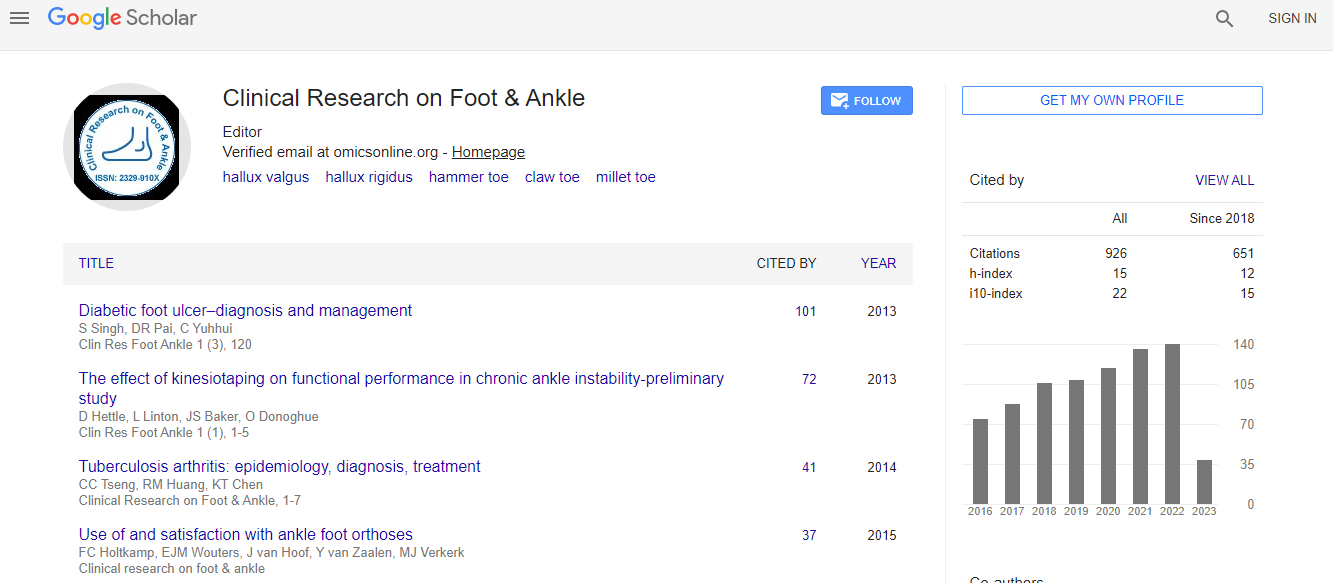Research Article
Toe Wounds Treated with Percutaneous Transluminal Angioplasty and Toe Amputation in Hemodialysis Patients with Diabetic Nephropathy: Wound Sites and Outcomes 2 Years after Surgery
| Kyoichi Matsuzaki1,2*, Akira Miyamoto3, Naohiro Hakamata4, Masahiro Fukuda4, Yasutaka Yamauchi4, Takako Akita4, Ryoji Kuhara4, Shingo Tezuka4 and Masaru Shiigai4 |
||
| 1Director, Department of Plastic and Reconstructive Surgery, Kawasaki Municipal Tama Hospital, Japan | ||
| 2Associate Professor, Department of Plastic and Reconstructive Surgery, St. Marianna University School of Medicine, Japan | ||
| 3Director, Cardiovascular Center, Kikuna Memorial Hospital, Japan | ||
| 4Cardiologist, Cardiovascular Center, Kikuna Memorial Hospital, Japan | ||
| Corresponding Author : | Kyoichi Matsuzaki Department of Plastic and Reconstructive Surgery Kawasaki Municipal Tama Hospital 1-30-37 Shukugawara Tama-Ku, Kawasaki 214-8525, Japan Tel: +81-44-933-8111 Fax: +81-44-933-8362 E-mail: k4matsu@marianna-u.ac.jp |
|
| Received December 09, 2013; Accepted December 30, 2013; Published January 04, 2014 | ||
| Citation: Matsuzaki K, Miyamoto A, Hakamata N, Fukuda M, Yamauchi Y, et al. (2014) Toe Wounds Treated with Percutaneous Transluminal Angioplasty and Toe Amputation in Hemodialysis Patients with Diabetic Nephropathy: Wound Sites and Outcomes 2 Years after Surgery. Clin Res Foot Ankle S3:002. doi:10.4172/2329-910X.S3-002 | ||
| Copyright: © 2014 Matsuzaki K, et al. This is an open-access article distributed under the terms of the Creative Commons Attribution License, which permits unrestricted use, distribution, and reproduction in any medium, provided the original author and source are credited. | ||
Related article at Pubmed Pubmed  Scholar Google Scholar Google |
||
Abstract
Introduction: When hemodialysis patients with diabetic nephropathy develop wounds on their feet, serious complications can occur. It is important to prevent wounds in those patients. In particular, a thorough follow-up is necessary for patients with a high risk of suffering a wound.
Patients and methods: Our study examined 26 patients with wounds confined to their toes for which percutaneous transluminal angioplasty and subsequent toe amputation were performed. The patients were able to ambulate after their wounds healed and therapeutic footwear was made. This study examined the outcomes 2 years after surgery, locations of amputated toes, and patients’ history of coronary intervention.
Results and Discussion: The 26 patients consisted of 20 men (64.4 ± 10.2 years) and 6 women (74.8 ± 10.6 years), indicating a significantly higher age in women. There was a history of coronary intervention in 15 of 26 patients. Toe amputation consisted of the first toe in 13 toes, the second toe in 8 toes, the third toe in 3 toes, the fourth toe in 4 toes, and the fifth toe in 8 toes. There were significantly more first toes than other toes. There were 19 patients with only 1 affected toe. In these patients, the first toe was the most commonly affected toe, followed by the fifth toe. The outcomes 2 years after surgery were survival in 17 patients and death in 9 patients. The mean age was 64.2 years in patients who survived and 71.7 years in patients who died. Seven of nine patients who died had a history of coronary intervention. Of the 17 patients who survived, 6 patients had re-amputation within 2 years after initial surgery. Five of the six re-amputation cases involved toe amputation on the ipsilateral foot. Thus, a thorough follow-up is necessary if there is continued burden on the foot with surgery.

 Spanish
Spanish  Chinese
Chinese  Russian
Russian  German
German  French
French  Japanese
Japanese  Portuguese
Portuguese  Hindi
Hindi 
